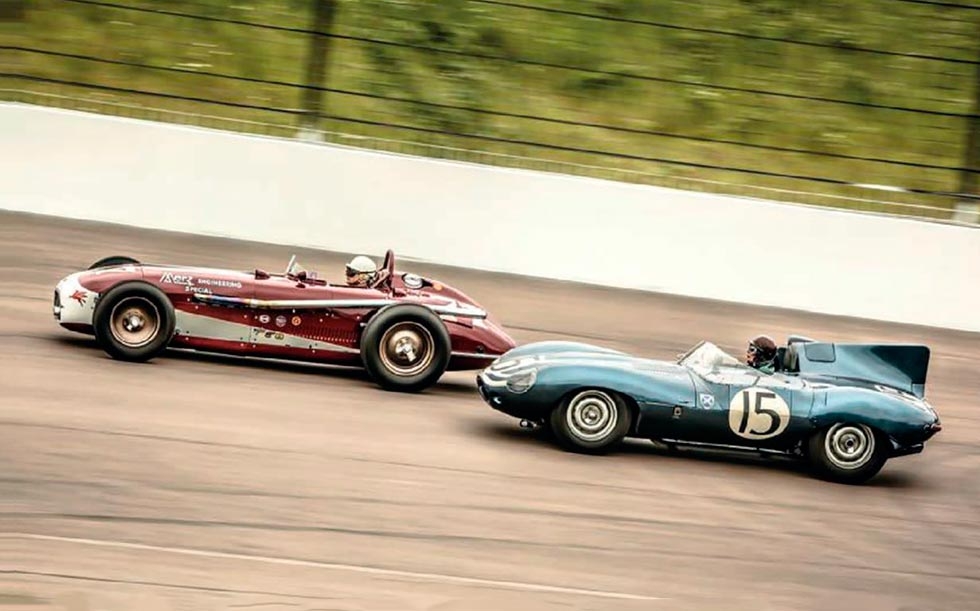
Jaguar versus Kurtis: recreating the incredible Race of Two Worlds In the 1950s, the best American roadsters crossed the pond to take on Europe’s finest. Mick Walsh recreates ‘Monzanapolis’ in Jaguar and Kurtis. Photography Tony Baker/LAT/Indianapolis Archive/Clive Beecham.
D-TYPE & KURTIS RELIVE EPIC RACE TWO TRIBES Monzanapolis revisited Le Mans racer and Indy roadster lock horns as we reunite two unlikely rivals.
Northamptonshire, a chilly breeze, a deserted track perimeter, no flags and ominous grey skies couldn’t be further removed from a baking-hot Sunday in Italy back in 1958, but several elements of this historic reunion couldn’t be more authentic. Parked together in the pitlane, the Kurtis roadster and Jaguar D-type look an unlikely pair, but both are veterans of one of the boldest motorsport competitions ever organised. The Race of Two Worlds, held twice on Monza’s dangerous, bumpy and ultra-fast banked track, was the vision of promoter Giuseppe Bacciagaluppi, the President of the Automobile Club of Milan. It was a match race between the fastest and bravest aces from both sides of the Atlantic.
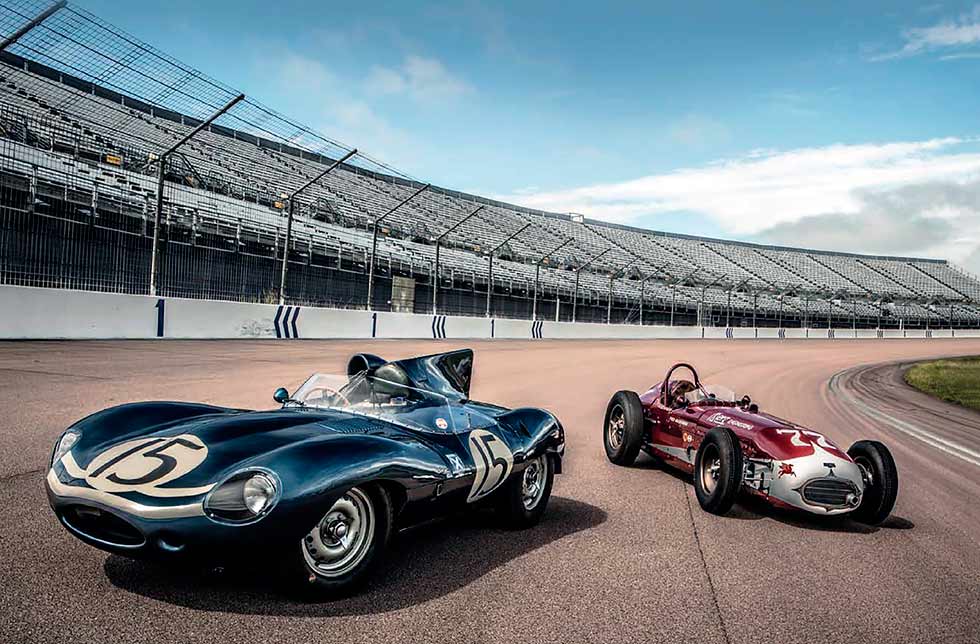
The D-type, resplendent in the patriotic colours of Ecurie Ecosse, ran on both occasions, with Jack Fairman an impressive fourth in 1957 – the highest-placed European against the Yankee oval specialists. As with the Americans, David Murray’s team had been tempted by the lucrative purse, and ignored the potential dangers of such a super-fast event.
The Kurtis Roadster – so called due to its low seating, thanks to an offset driveline conceived by designer Frank Kurtis – couldn’t look more different to its sleek, streamlined rival. This Offenhauser-powered 1954 machine, better known as the Merz Engineering Special, also has remarkable history. It survived five Indianapolis 500s, plus a trip to Monza for the second Euro-American challenge. Like the D-type, it is remarkably original after a tough racing life, but, unlike the valuable Jaguar, it continues to race and prove that American engineering can still match and beat Europe’s finest.
The two cars may look very different, but they share several advanced features for the era, with lightweight wheels and disc brakes. Both were conceived for a specific goal – Indy glory for the Kurtis and Le Mans for the Jaguar. Designers Kurtis and Malcolm Sayer came up with bold, fresh designs that had a massive influence. The Roadster inspired AJ Watson and dominated Indy through the 1950s, while the D-type’s legacy continued to the iconic E-type road car. But they couldn’t be more different on the track.
Driving a D-type is special, but to follow the Kurtis and experience the same view that Fairman and, later, Ivor Bueb did at Monza is a top ‘pinch yourself ’ moment. As Geraint Owen blasts alongside, we’re back in Italy – the chrome exhaust punching out a deep burble, in contrast to the Jaguar’s raucous roar, and those huge rear Halibrands spinning inches from the D-type’s sexy, all-enveloping wings. The sound, heat, feel and view inside the Jaguar as we blast around Rockingham’s shallow banking is deeply evocative of those courageous duels. Fairman sat in this very seat and, to the shock of the Americans, led the field for a few laps before the Offy-powered, two-speed rockets blasted clear.

The D-type feels stable at speed, with no buffeting, but the live axle jumps around over the bumps. The steering inspires and, once you’re used to the acutely angled lever, the gearchange is positive and direct with a short throw. The performance is wonderful, the torque coming on strong from 3000rpm, but above 4500 the ‘six’ really delivers with smooth, urgent power. Only the brakes unnerve you, the Citroën-like feel never inspiring with its light action. A minor surprise is poor ergonomics in the famous endurance racer, with the rev counter set to the left – an unwelcome glance away when you’re blasting along at 160mph on rough banking. It’s a fantastic car, though, in which you quickly feel comfortable, unlike the brash Kurtis. Only its precious original condition and high value deter me from pushing harder when Owen again appears in my rear-view mirror, the view framed by the D-type’s signature fin. Flashbacks don’t get more vivid.
Just getting into the Roadster and trying to see over the bonnet is a challenge. Four essential gauges on a steeply raked gloss dash with flat, four-spoke steering wheel contrast with the aviation-style satin-black cockpit of the D-type. Sitting deep alongside the transmission line, I need padding to see the track ahead, while the tall rear wheels seem unnervingly close to my ear. Amazingly, 1950s Indy legends often wore T-shirts in this dramatic hot seat.
The Kurtis is all about brute force, the 4.2-litre Offenhauser ‘four’ producing mighty torque at low revs and clean rocket power right through the rev range. The gearbox has a tight, short gate with a heavy action, while the push-me, pull-you steering via long drag arms is direct and well weighted. Once going, the performance is spectacular. It feels weird when you lift off into the turns, the locked differential trying to push you straight, but your cornering speed quickly climbs as confidence builds and you stay on the power. To throw the Roadster into bends takes huge reserves of the right stuff and, after a few laps, I’m in awe of Jimmy Reece, who gunned this actual Kurtis around Monza at 165mph.
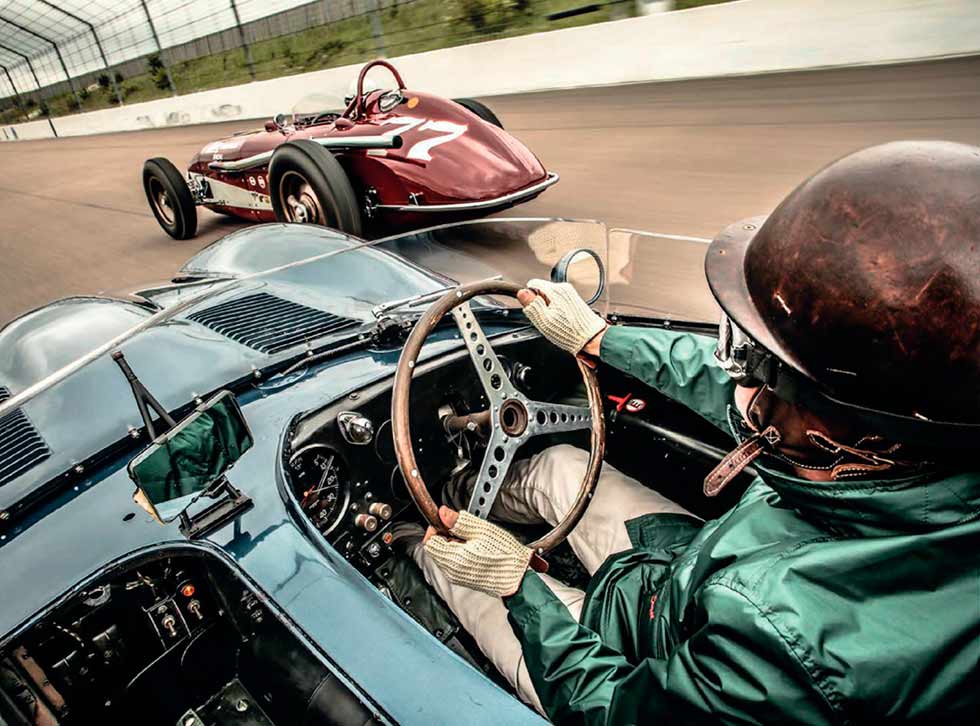
Back in the pits we’re all moved by the meeting of these two wonderful machines, but it’s Fairman – the quickest Brit at Monza – who’s on my mind. With his previous experience on banked circuits, he was a key figure in the Ecurie Ecosse team for the Race of Two Worlds. Neither Jock Lawrence nor Ninian Sanderson had raced at Monza and, not surprisingly, found the steep banking intimidating, not to mention the nagging feeling that a tyre might fail. Fairman knew full well the problems after previous blowouts at high speed when his record-breaking XK120 burst a tyre at Montlhéry in 1952. ‘I had mixed feelings about the race,’ recalled Fairman in the Jaguar apprentices’ magazine. ‘It takes a long time to get used to it. It’s a bit hairy skimming round the top of the banking on the bumps, and the car receives a fearful pounding. Acquiring the correct technique is not easy. The tendency is usually to drive too low as you are scared of getting too high and motoring smartly over the top. In the Jaguar, the best technique is to go higher than seems necessary, and this is frightening.’
Dunlop’s Vic Barlow also advised drivers to run as high as possible. Driving too low at high speed caused the car to drift upwards, which caused more tyre scrub, wear and heat, with potentially disastrous consequences. Fairman recalled that the banking was smoother at the top, and struck an agreement with the faster Americans that they’d undertake for safety.
In 1957, organisers set a 140mph minimum qualifying limit that both Lawrence and Sanderson failed to reach. Fearing he’d lose prize money, Murray got Fairman to qualify the other D-types wearing borrowed helmets. “I’d gone off for a swim because I’d had enough of these hot, smelly, noisy cars,” he said, “and, just before I dived in, a mechanic came chasing after me saying: ‘Mr Murray wants you back.’ I was furious and, looking an idiot with Ninian’s yellow helmet perched on top of me ’ead, I qualified considerably faster than I had done in my own.”
When race day arrived, Fairman found himself right at the back of the grid but, as soon as Luigi Villoresi’s pace car peeled off, the situation dramatically changed – much to the surprise of the American drivers. Feeling a “bit of a Charlie right at the tail of the queue,” Fairman decided to make full use of the D-type’s four-speed gearbox and gave it the spurs. As the flag fell, the metallic-blue sports-racer was yowling through the field.
The American hotshoes were handicapped at the start by their two-speed ’boxes and the Jaguar flashed past: “I was just about to ease off to avoid creasing an American’s tail when the two roadsters in front suddenly parted, so I kept my foot down and nipped between them.”
He was up to third and, such was his speed high on the banking, that he then astonished everyone by passing both favourites – Jimmy Bryan in the Dean Van Lines and Troy Ruttman with the John Zink Special.
Just imagine the expressions of the American crews in the pits as the pack reappeared with the vivid blue Jaguar leading. “I was all on my own,” said Fairman, “about 150 yards ahead of the next car and going like a dingbat. It was a moment I shall remember for some time.”
Fairman managed to hold the lead for another lap but slowly the roadsters picked up extra speed and started to pass. Down in the pits, Murray and Barlow were getting agitated and instructed Fairman to slow down, but still the D-type continued to lap at 155mph.
The first heat was won by Bryan at a staggering 162mph average, with Pat O’Connor second in the Sumar Special. Fairman dropped down to eighth, leading the D-type train but five laps behind the fastest roadster.
The results don’t hint at the full story because the rough course gave the roadsters a pounding. Between heats, the American mechanics worked hard to fix split fuel tanks and weld up suspension components. The D-types, despite being fresh from the Le Mans enduro, stood up well.
Bryan, who was known as the Arizona Cowboy, continued his dominance in the second heat with a record lap of 282kph (175mph). Fairman took fifth but, for the third heat, the fast-improving Troy Ruttman in the John Zink Special pipped Bryan, with Fairman coming fourth. The course had taken its toll on the American teams – just three were running at the final flag, ahead of the D-types. Fearless Jack was three laps clear of Jock Lawrence.
After the final classification, Bryan – who seemed to be chewing cigars throughout the event – topped the table, with Fairman fourth. The winner’s average through the three heats was 163mph; Sam Hanks’ speed at Indy a month earlier had been ‘only’ 135mph!
Maybe due to the lack of Italian stars or the fierce temperature, the crowd was a disappointingly small 20,000, but all had been thrilled by the dazzling spectacle. The Jaguars had impressed everyone, particularly Fairman, who averaged 151mph: “I was filled with admiration for the way our cars stood the test, especially as they were far from new.”
Murray felt he’d vindicated his decision to enter after the pre-event fears and criticism, but the major share of the prize money no doubt pleased the Scotsman. The reception back in Edinburgh was lukewarm, though. “They took no risk with ratepayers’ money,” he remembered. “No red carpets, no cigars or champagne. That didn’t upset me, but we expected something more exotic than vegetable soup.”
Fairman’s D-type continued to have a very active racing life, including the Swedish Grand Prix, Sebring, Spa (twice), the Nürburgring 1000km and Le Mans before it was back for a second Monzanapolis in June 1958.
For the return of the Race of Two Worlds, the Italian teams joined the battle with dramatic specially built machines, while the driver line-up featured a gallery of Grand Prix stars headed by Stirling Moss, Mike Hawthorn, Luigi Musso and Phil Hill. The greatest coup, however, was talking Juan Manuel Fangio into joining the US team with the Dean Van Lines Roadster, an ex-AJ Foyt Indycar that the Maestro coolly piloted to third in practice at 171mph. Yet it was the pace of Luigi Musso that brought the locals out in force on another sweltering Sunday. The stylish Italian pushed Ferrari’s special 400bhp 4-litre Super Squalo to the limit and snatched pole at 281kph (174mph) from Bob Veith in the Bowes Seal Fast Special.
Fairman was back, too, in an unsorted Lister. He struggled for pace but still pipped Ivor Bueb in XKD 603 at the back of the field.
Much to the disappointment of all, Fangio’s car was pushed off the grid with a broken engine; the American team had failed to finish repairs after a cracked piston had been discovered earlier in the day. Hawthorn was originally scheduled to drive the big-banger Ferrari but, not liking the banked circuit and suffering stomach pains, happily gave his seat to Musso. With his extra gears, poleman Musso got the jump on the Americans and, to the joy of the locals, led the first lap ahead of Eddie Sachs (Jim Robbins Special), Bryan and Jim Rathmann (Zink Leader Card Special). Drama continued throughout the 63 laps, with Rathmann taking control. Musso pitted after 26 laps suffering from breathing in the methanol fumes, and Hawthorn reluctantly took over to the finish. Sachs’ challenge ended with a conrod through the side of the crankcase but the battle for third raged between Bob Veith (Bowes Seal Fast Special) and Moss (Eldorado Special). Reece came eighth in ‘our’ Kurtis while Bueb, the last finisher, completed only 45 laps.
Fangio’s car failed to appear for heat two, which Rathmann won from Veith, but all eyes were again on the dramatic slipstreaming battle for third between Moss, Veith, Bryan and Troy Ruttman until magneto problems slowed Moss. Reece took sixth and Bueb eleventh, plugging on and picking up places as others failed.
Fangio finally started the last heat but managed only a lap as Rathmann led from the go. Starting at the back due to a failed first gear, Moss roared up to fourth but then the banking began to take its toll. First Veith lost a wheel and then, on lap 41, Moss failed to appear. To his horror, the steering failed while flat-out, and he cannoned along the guardrail before coming to rest unharmed on the infield. Reece, getting more confident, brought the Kurtis home fifth. Rathmann was a clear winner in the aggregate result, netting £11,000 from Bryan. The shared Ferrari of Musso, Hawthorn and Hill was third after bigger and bigger holes had been cut into the bodywork to clear fumes and cool the cockpit.
Reece claimed fifth and Bueb ended up highest of the Ecurie Ecosse team in ninth. The atmosphere between the Americans and the Europeans was mostly cheery, but some of the visitors – particularly Bryan – were on a mission, as Phil Hill observed in Motor Sport: ‘He just wanted to blow these Italian puppies off and go home. I remember him criticising me for carrying an umbrella as a sunshade, as if there was something effete about it!’
Monza was the first time that the Californian wore a seatbelt because the evil-handing Ferrari 412 suffered terrible bouncing at speed on the banking: ‘Musso was damn near getting thrown out, so we put a belt in.’ The Italian had given his all for Ferrari and his country at Monza, his courage impressing a spectating Dan Gurney. Tragically, he was killed at Reims the following weekend. This dangerous era stretched across to America where many of the popular visitors didn’t last much longer. Reece’s luck ran out in September ’1958 when he lost control of his Kurtis 500G at Trenton.
Denis Jenkinson had marvelled at the Monza spectacle, as his lengthy Motor Sport report confirmed: ‘There have now been 1000 miles of racing on the banked track, plus all the practice, and not one drop of blood – so much for the pessimists who boycotted the race last year. Some people are hard to please. With cars lapping at over 170mph and only inches apart, there were still people who were unimpressed – “It’s not racing” they said!’
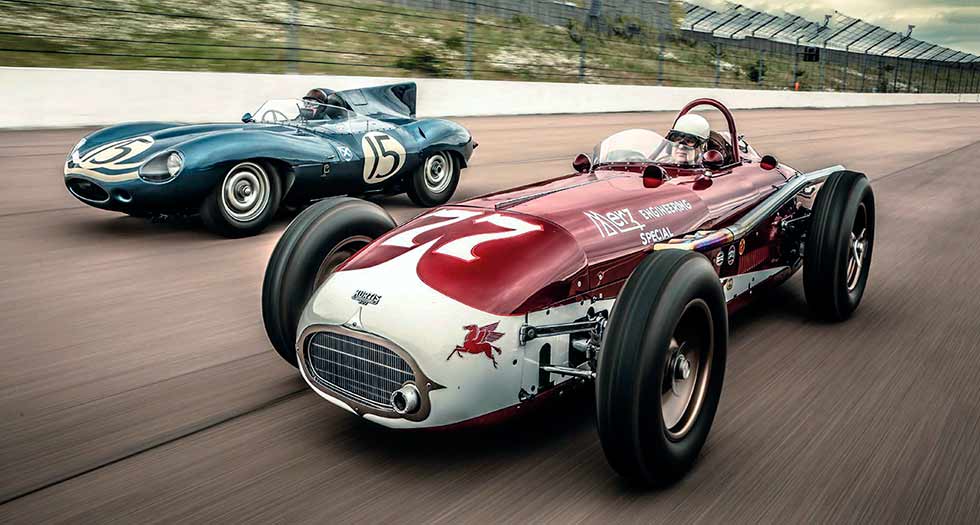
‘A lot of people are getting mixed up on the difference between the art of high-speed driving and motor racing,’ continued Jenks. ‘Grand Prix racing is the demonstration of driving skill, Monza is motor racing. The Indianapolis crowd have a great sense of humour that is different and makes a change. Harry Schell was bleating about the race being “Stupid and silly” and a voice was heard to say “How’d he know? He was so far behind he didn’t even see it”.’
American enthusiast Pierce Carlton, now in his 80s, still vividly recalls his trip to Monza in 1958: “I was on honeymoon in Europe, and I remember seeing the Italian Lakes for the first time and thinking this is heaven. On race day the trains were packed from Milan to Monza, but the crowd wasn’t overwhelming at the track. We got a great view on the main straight and the buzz when Musso came round in the lead was terrific. I’d been to sports car races in the US, but never seen speed or sound quite like this.”
Driving these two great cars, reading the reports and chatting to an eye-witness all lend history a vivid and privileged dimension. Rockingham is as authentic as it gets in England – particularly driving anti-clockwise – but there’s nothing like taking the cars back to Monza. One of the highlights of XKD 603 ownership for Clive Beecham and his trusted specialist David Brazell was the opportunity to run on the banking during the 2015 Mille Miglia.
“We ignored the regularity and just went for it,” enthuses Beecham. “I really enjoy researching a car’s history, so it was an amazing feeling looking down that bonnet as we entered the banking. We were amazed how steep and bumpy the track was, and how strong the D-type must have been to take the punishment direct from Le Mans. It was an emotional moment for all of us.”
Kurtis owner Owen is also planning a return this June to run with the Historic Grand Prix Car Association: “Rod Jolley will also race with the Monza Lister, and hopefully Fred Harper with the ex-Ray Crawford Mirror Glaze Special, which ran in both the ’1957 and ’1958 events. We’ve got to get a photo on the banking.”
The passion of these two enthusiasts is a fitting tribute to the heroes who braved the spectacular events. To place Rathmann’s winning average of 166mph in context, it wasn’t bettered at the Daytona 500 until 1980, or at Indianapolis until 1986. “It was the fastest, toughest track we’d ever seen,” he said, “but a lot of us were young and dumb and broke so, you know, it was just another race track. A sprinter at Salem scared the hell out of me but I didn’t mind Monza.”
AJ Watson was equally cool about the Italian challenge: “It was a lot of fun because those Fl guys really didn’t have a chance. Their cars just weren’t very good. Not for that place.” Ironically, the roadster era was nearly over. Just three years later, Watson’s world would be shaken up by the British Invasion at Indianapolis, when Jack Brabham’s Cooper kickstarted the rear-engined revolution at the Brickyard.
Thanks to Clive Beecham, David Brazell, Geraint Owen and Rockingham Speedway (www.rockingham.co.uk)
Tech and photos
TECHNICAL DATA FILE SPECIFICATIONS JAGUARD-TYPE
Sold/no built 1954-’1957/62 (plus 16 Jaguar XKSSs)
Construction magnesium-alloy semi-monocoque, with tubular steel front sub-frame
Engine iron-block, alloy-head, dry-sump, dohc 3442cc ‘six’, with crossflow head, triple twin-choke Weber DC03 carburettors;
Power 250bhp @ 6000rpm / DIN nett
Torque 248lb ft @ 4500rpm / DIN nett
Transmission all-synchromesh four-speed manual, driving rear wheels via LSD
Suspension: front independent, by longitudinal torsion bars, wishbones, a-r bar rear live axle, twin trailing arms, transverse torsion bar; telescopic dampers f/r
Steering rack and pinion
Brakes 12 ½ in (324mm) discs, with gearbox-driven Plessey pump servo
Wheels and tyres alloy 16in centre-lock discs, with 6.50x16in Dunlop Racing crossplies
Length 12ft 10in (3910mm)
Width 5ft 5 ½ in (1660mm)
Height 3ft 8in (1120mm)
Wheelbase 7ft 6 ½ in (2300mm)
Weight 1930lb (875kg)
0-60mph 4.7 secs
Top speed 160-180mph (depending on axle ratio)
Price new £3633 (’1954 UK)
Now (2018 UK) from £5m




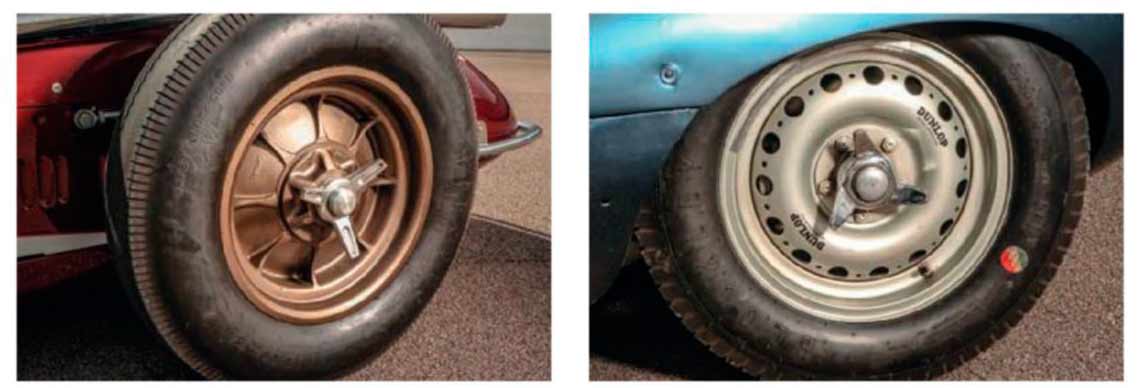
‘IT WAS THE FASTEST TRACK WE’D SEEN, BUT WE WERE JUST YOUNG, DUMB AND BROKE’
‘TO THROW THE KURTIS ROADSTER INTO BENDS TAKES HUGE RESERVES OF THE RIGHT STUFF’
Jaguar D-type XKD 603
Few sports-racers have a history to match the 1956 works car XKD 603, the last of three long-nose D-types built for Le Mans. It made its mark immediately, with Mike Hawthorn – the first of seven Le Mans winners to race it – setting a lap record at Silverstone during the Daily Express Trophy. Its international career with the factory (1956) and Ecurie Ecosse (1957-’1959) included four entries at La Sarthe. Inexplicably sold to an American owner by Ecurie Ecosse as the ’1957 Le Mans winner, it returned to the UK in 1973 when bought by Anthony Bamford, who soon discovered its true identity. It was extensively campaigned in historic racing, with Willie Green taking it back to Le Mans in 1973 and ’1978.
After Jonathan Turner and Stefan Ziegler, XKD 603 was acquired in 2014 by Clive Beecham, but is still prepared by David Brazell. “For me, this is the holy grail,” says Brazell. “It may look Scottish but there’s the original green where the blue paint has rubbed off. After 40 years, it still blows my socks off. It carries all the scars of its fantastic history, including the slots in the bulkhead for the fuel-injection pipes. We also have the rear air duct that was fitted for Monza. Thankfully, Bamford took off the original bonnet and tail when it was raced.”
Beecham is just as enthusiastic and, as with all of his cars, has built up a mouthwatering archive including the works logbook compiled by Phil Weaver: “It’s an amazing record of every race preparation right down to hotel bookings, and all written neatly in fountain pen.”
Beecham has even taken XKD 603 back to Merchiston Mews to reunite it with 93-yearold Stan Sproat, the Ecurie Ecosse mechanic who still regards this as his car. “Stan was determined to sit in the cockpit,” says Beecham, who would love to find the old Leyland Tiger transporter. Ever the purist, one of the first changes he made was to reinstate the second nose stripe, which David Murray had removed when he sold it in 1959.
Highlights have included convoying on the Mille Miglia with XKD 605: “They felt like two Spitfires in echelon and it was great to see so many Brits waving us on, but early morning runs across London and empty roads near David’s workshop can be just as memorable.”
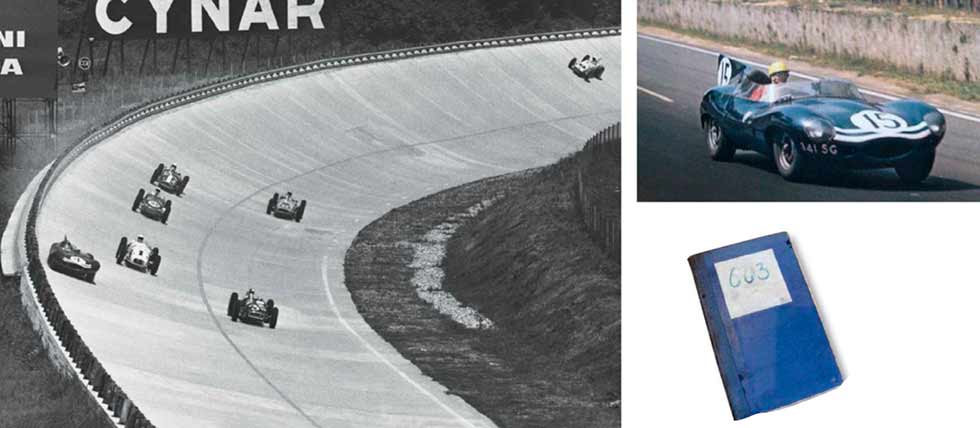
Merz Engineering Special
One of nine 500C cars built in Frank Kurtis’ shop in Glendale, California by a talented team including Art Ingels and Dick Troutman, chassis 376 is best known as the Merz Engineering Special. A veteran of five Indianapolis 500s, its stellar race history began in 1954 when Fred Agabashian started 24th and worked his way up to sixth. The present livery honours that debut at the Brickyard. The following year, Walt Faulkner blasted the Offy-powered car to fifth. In 1958, after Indy, it was shipped – along with nine other roadsters – from New York to Genoa for Jimmy Reece to drive at Monza.
From 1960-’1962, it competed in a few USAC races before its retirement – others to have driven it include Johnny Parsons, Ed Elisian, Gene Hartley and Richard ‘Red’ Amick. Saved from the brutal development of super-modified race cars, ‘376’ remains one of the few original Kurtis roadsters left, with chrome-moly chassis, bodywork and axles.
The Merz Engineering Special returned to the track for the 2007 Monterey Historic Races, but in 2014 it headed back to Europe for the first time since 1958 for new owner Geraint Owen: “I enjoyed running a Kurtis sports car and wanted a ’50s single-seater. For Cooper-Bristol money, the Kurtis was a potential front-runner and, once I discovered this car had Monza history, my ears pricked up. I ended up bidding into the early hours on a cold night. My wife discovered me sitting in my race suit with riding socks on to keep warm, and thought I’d lost it.”
Owen works on his own cars and loves the challenge of making them competitive: “It’s much easier to work on than my sports car because you can get all the panels off in 20 minutes. On the dyno, you struggle to hold it down – it has torque like a truck, with power of 370bhp at 5300rpm. It’s sluggish off the line but once going you’re soon up with the Maserati 250Fs, which is exciting.
“It has masses of grip. The more you lean on it, the more it keeps giving. The sports car requires a precise style, but the roadster is like a big Nash. I’m not brave enough to slide it yet, and through fast corners it tends to understeer. I had a great race at Spa last year, and through Blanchimont it was honking along at 120mph. The disc brakes cool well, and the steering is direct. It’s an impressive package, and I’m really looking forward to taking it back to Monza.”






